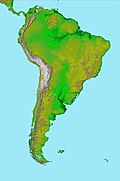| Choiyoi Group | |
|---|---|
| Stratigraphic range: Permian-Triassic | |
| Type | Group |
| Unit of | Frontal Cordillera, San Rafael Massif, Principal Cordillera |
| Sub-units | El Palque Fm., Horcajos Fm., Portezuelo del Cenizo Fm., Tambillos Fm., Vega de Los Machos Fm. |
| Underlies | Mendoza & Cuyo Groups |
| Overlies | Carapacha Formation (Sierra de Calencó) |
| Area | >200,000 km2 (77,000 sq mi) |
| Thickness | 2–4 km (6,600–13,100 ft) |
| Lithology | |
| Primary | Basaltic lava flow, breccia, andesite, rhyolitic ignimbrite |
| Other | Dacite |
| Location | |
| Country | Argentina Chile |
| Type section | |
| Named by | Stipanicic et al. |
| Year defined | 1968 |
Choiyoi Group (Spanish : Grupo Choiyoi [note 1] ) is a Permian and Triassic-aged group of volcano-sedimentary formations in Argentina and Chile. The group bears evidence of bimodal-style volcanism related to an ancient subduction zone that existed along the western margin of the supercontinent Gondwana. [1] [2]
Contents
The Choiyoi Group has a large areal extent through western Argentina and parts of Chile, covering at least 200,000 square kilometres (77,000 sq mi), but probably around 500,000 square kilometres (190,000 sq mi). While the subsurface extent of the group is large, exposures in Argentina are most common in the Frontal Cordillera, the San Rafael Massif and the Principal Cordillera of southern Mendoza and northern Neuquén. [3] In parts the group reaches thicknesses of 2 to 4 km. [1]

The plutonic equivalent of the Choiyoi Group volcanic material are mostly granitoids. [1] The remnants of the magmatic arc that produced much of volcanic material is now preserved as a series of batholiths, including the Coastal Batholith of central Chile in the Chilean Coast Range. During the Permian, the zone of arc magmatism moved 350 kilometres (220 mi) inland from the Chilean Coast Range, reaching San Rafael about 280 million years ago. [2]
Many Triassic basins in southern South America, including Cuyo Basin, have their lowermost sections made up of Choiyoi Group formations. [4]
